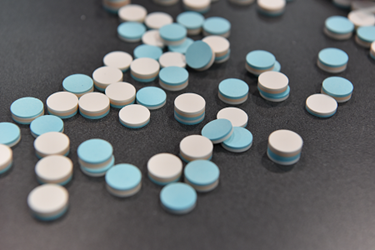3D Printing In The Pharmaceutical Industry — Where Does It Currently Stand?
By Jerry Martin

In 2015, Aprecia Pharmaceuticals produced the first tablet manufactured through 3D printing to be approved by the FDA. Two years later, GlaxoSmithKline completed a study where inkjet 3D printing and ultraviolet (UV) curing were used to create tablets that treat Parkinson’s disease. With applications in controlled release, short-run medicines, and even the potential for on-site printing at pharmacies, 3D-printing technology has the ability to transform the pharmaceutical industry.
Not surprisingly, established players continue to invest in 3D-printing research, while newer manufacturers are also breaking into the pharmaceutical space. Such experiments can open the doors for personalized medicine and improvements in clinical trials, benefitting patients and manufacturers alike.1
Controlled Release
Demand for controlled-release pharmaceuticals, sometimes referred to as 4D pharmaceuticals because of their tendency to change shape during digestion or operate for extended times, is growing as patients’ desire for convenience expands. The reduced dosing frequencies extended-release products offer can increase patient compliance in those who take multiple doses of a drug per day—patients can take one pill in the morning instead of every few hours, or perhaps even one pill for a week or more. Pediatric care is a key application area for extended-release pharmaceuticals. Because children range in body mass, it can be difficult to manage proper dosing in youths. The solution is often to give children multiple low-dosage pills or a larger pill that must be manually cut. Extended-release tablets offer a more controlled method of delivery.
In the example of Aprecia Pharmaceuticals, 3D printing was used to reformulate the anti-epileptic medication levetiracetam. The new product, Spritam, has a highly porous structure that could not be achieved with traditional manufacturing.2 This structure causes the pill to dissolve in seconds upon contact with saliva, helping both elderly and young patients suffering from trouble swallowing pills, known as dysphagia.
This innovative development was achieved through a proprietary powder bed and inkjet 3D-printing technology known as ZipDose. In manufacturing, an initial powdered layer containing the drug itself is laid down. That first layer then passes under an inkjet printhead, and a binding liquid is printed at specified locations along the powdered sheet. Successive layers are then printed up to 40 times, depending on the size of the tablet. Printing the layers allows the drug to be packed more tightly. A single tablet that would normally hold 200 mg can be layered to hold 1,000 mg. The result is a high-dose medicine that is easy to swallow for epileptic patients and breaks down inside the body to administer a steady dose over time.
Another proposed application for controlled-release drugs is expedited formulation testing. Studying the performance of different excipients in terms of the tablets and dissolution properties is much faster when 3D printing the solid dosage forms than using traditional manufacturing at a larger scale.
While controlled-release 3D-printed capsules are closer to impacting the pharmaceutical industry’s future, electronic pills are on the horizon, too. Scientists recently designed a 3D-manufactured, ingestible electronic pill capsule that can be controlled using Bluetooth wireless technology and connected to the user’s smartphone. The capsule can be customized to deliver drugs, sense environmental conditions, or both, and can reside in the stomach for at least a month.3
Short-Run Medicines
The short-run properties of 3D manufacturing lend themselves to patient-specific drugs as well. As pharmaceuticals become more personalized, the demand for patient-specific solutions increases. According to a white paper by PMMI, The Association for Packaging and Processing Technologies, the pharmaceutical industry is being transformed by a new emphasis on personalized care. It also notes the industry is witnessing a decline of blockbuster drugs.4
3D printing also holds tremendous promise for orphan drugs, which are designed to treat rare diseases that are sometimes not developed by the pharmaceutical industry due to economic reasons. The number of such rare diseases is estimated to be between 4,000 and 5,000 worldwide.5
In today’s landscape, large drug companies tend to look for a disease with a large population and develop one drug to treat that population, a method that is costly and difficult in the clinical trials stage. New players in the industry are using DNA to identify patient subpopulations from which to conduct clinical trials, and thus that same drug might have a better success rate. For example, HIV patients are now routinely tested for a genetic variant that would make them more likely to have an adverse reaction to the antiviral drug abacavir (Ziagen).6
3D printing can also expedite the clinical trial process through speed and flexibility inherent in its ability to produce small batches of drugs with different compositions. With 3D printing, companies can create multiple versions of a drug for variant populations and produce them in short-run batches.
Regulations
To date, Spritam is the only FDA-approved 3D-printed pharmaceutical on the market. However, the FDA sees 3D printing as a tool to improve drug quality and consistency. One encouraged practice is multiple adjacent printer heads across a conveyer belt, allowing for continuous manufacturing. Although no good manufacturing practice guidelines have been administered for 3D-printed pharmaceuticals, the FDA established guidelines for 3D printing of medical device products in 2017.
3D-printing technology is already being applied to medical device and surgical manufacturing, particularly in research and development. Using 3D printing, hearing aid company Sonova is able to mass-produce hundreds of thousands of custom-made products per year. Despite the high quantities, each product is tailored for its wearer’s individual needs.7 In fact, research company MarketsandMarkets.com estimates the use of 3D printing for medical devices alone could reach a market value of $2.13 billion just two years from now.8
Researchers suggest 3D printing can be part of the pharmacy’s future, too. If common medications for chronic diseases were available in a pharmacist’s 3D printer, a customized “polypill” could be created that could potentially contain all the medications a patient needs in one pill. However, there is some resistance to this movement, as it would be more difficult to regulate and ensure safety at local pharmacies than at manufacturing facilities. The practice also opens up concerns about 3D printing and intellectual property, standardizing computer programming, the business model, and the potential for counterfeiting drugs.
Barriers To Entry
Because the format is so new, navigating the unregulated processes for developing 3D pharmaceuticals is costly, posing a hurdle for some players. The methods of 3D printing are quite varied, even within solid dosage drugs, making it too early to define best practices. Inkjet 3D-printing methods are of particular interest to the pharmaceutical industry because they have many parallels with current manufacturing processes and may offer a more efficient, longer-term printing solution. However, 3D printing will not replace today’s production methods for some time.
Additionally, more research is needed on better binding polymers for structural variations and patient safety. Over time, as companies submit 3D-printed products to the FDA for review, the industry will have a better sense of best practices and regulations.
References:
- https://www.sciencedirect.com/science/article/pii/S0378517317305938
- https://www.chemistryworld.com/feature/3d-printing-in-pharma/3008804.article
- http://news.mit.edu/2018/ingestible-pill-controlled-wirelessly-bluetooth-1213
- https://pmmiprod3ebiz.personifycloud.com/PersonifyEbusiness/Default.aspx?TabID=251&productId=21361728
- https://www.orpha.net/consor/cgi-bin/Education_AboutOrphanDrugs.php?lng=EN
- https://www.genome.gov/27530645/faq-about-pharmacogenomics/
- https://www.sonova.com/en/features/3d-printing-technology-improved-hearing
- https://www.marketsandmarkets.com/Market-Reports/3d-printing-medical-devices-market-90799911.html
About The Author:
 Jerry Martin is an independent consultant to pharmaceutical manufacturers and equipment suppliers for filtration, single-use manufacturing, marketing, business development, and regulatory compliance. He was previously SVP, marketing and global scientific affairs, for Pall Life Sciences, where he served the pharmaceutical, biotech, medical device, and vaccine industries for over 37 years. He is currently chairman emeritus of the Bio-Process Systems Alliance, the single-use manufacturing trade association, and a member of the USP Expert Panel on Plastic Systems Used for Manufacturing Pharmaceutical Products. He holds an M.Sc. in microbiology from the University of Toronto.
Jerry Martin is an independent consultant to pharmaceutical manufacturers and equipment suppliers for filtration, single-use manufacturing, marketing, business development, and regulatory compliance. He was previously SVP, marketing and global scientific affairs, for Pall Life Sciences, where he served the pharmaceutical, biotech, medical device, and vaccine industries for over 37 years. He is currently chairman emeritus of the Bio-Process Systems Alliance, the single-use manufacturing trade association, and a member of the USP Expert Panel on Plastic Systems Used for Manufacturing Pharmaceutical Products. He holds an M.Sc. in microbiology from the University of Toronto.
Many opportunities are being explored for introducing solid and liquid APIs into solid dosage forms using 3D printing, including the potential for cross-sectional variability and layering. Further research into dynamic 3D printing of drugs can offer solutions for patient compliance, convenience, and safety.
Healthcare Packaging EXPO (Sept. 23 to 25; Las Vegas Convention Center), co-located with PACK EXPO Las Vegas 2019, will provide a powerful opportunity for pharmaceutical and medical device manufacturers to converge and address evolving consumer and regulatory demands. Both owned and produced by PMMI, the shows will also offer educational programming and opportunities to cross-pollinate ideas among industries. Register and learn more at https://www.hcpelasvegas.com/.
